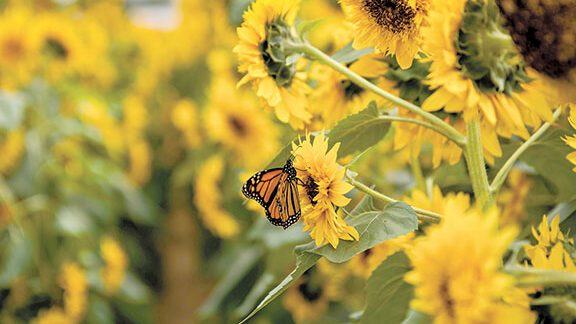
By Gloria Stravelli
WEST LONG BRANCH – Native plants are at the center of a holistic approach to the natural world that recognizes gardens as interdependent ecosystems of flora, insects and wildlife.
Avid gardener Kim Rowe is the force of nature behind the newly formed Monmouth Chapter of the Native Plant Society of New Jersey, which will hold its first meeting at 5:30 p.m. June 1 at Piasecki Hall on the campus of Monmouth University campus.
“I’ve always been a gardener,” said Rowe. “I’ve been a member of the New Jersey Native Plant Society since 2013 when I read a book that changed everything about the way I garden.
Rowe said that book, “Bringing Nature Home: How Native Plants Sustain Wildlife in Our Gardens” by Douglas Tallamy, taught her the importance of native plants. “I converted my entire garden.”
Tallamy is a professor in the Department of Entomology and Wildlife Ecology at the University of Delaware. He is the author of several books, including “Nature’s Best Hope: A New Approach to Conservation That Starts in Your Yard,” and is credited with launching the native plant movement.
Rowe said prior to reading Tallamy’s book, she’d always designed perennial gardens in the English tradition using nonnative plants mostly from Europe or Asia.
“That’s what I learned when I was in college,” she said, “and I kept gardening my whole life that way until I read this book and I said, ‘I have to change everything.’ ”
Rowe transformed her entire garden using native plantings that help support local pollinators and wildlife.
“I learned from ‘Bringing Nature Home’ that your garden shouldn’t just be something beautiful you look at,” she said. “It also should be a wildlife habitat because the insects that we need in our gardens can pollinate our plants” and provide food for many species.
She used the example of monarch butterflies which only breed where milkweed grows as it is the sole food source for the monarch larvae. Adult butterflies will feed on nectar from many flowers, but without milkweed monarchs won’t grow.
“It’s important to supply those native plants in your garden otherwise these butterflies… can’t survive.”
Rowe stressed the interdependence inherent in the garden ecosystem.
“The vast majority of the food we eat as humans depends on pollinators,” she said. Those pollinators include honey bees and native bees, butterflies, moths and other insects.
And sustaining those populations isn’t just important for us, said Rowe, but for the birds as well.
“A large portion of (a bird’s) natural diet is insects and the only thing they can feed to their babies are insect larva. So they require a lot of insects in order to nest and reproduce.”
As an entomologist, Tallamy’s research centers on the relationship between insects and plants.
In the early 2000s he observed the lack of caterpillars on the plants around his newly purchased home, noting many of those plants were nonnative.
He measured how many species of insects could live on a native dogwood, Rowe explained, and found the number was 117; a nonnative Korean dogwood, on the other hand, could sustain zero.
Because of this complex relationship, Tallamy promotes a concept called the “home-grown national park.”
“People are being encouraged to use their yards as habitat” for native species, Rowe said, because so much native habitat has been eliminated for the construction of roads, houses and other buildings.
“Only about 3% of the lower United States remains as untouched native habitat,”
she said. “The rest has been altered in
some way.”
And lest you think otherwise, lawns are not native habitat. Neither are vegetable gardens and land used for agriculture, Rowe said.
“It used to be there was always milkweed over large swaths of this country,” Rowe explained, but because of farming, paving and lawns, “there’s hardly anything left.”
While Rowe said it is “scary” to think about the problems, “the good thing is every individual who owns a small plot of land can contribute to creating a native habitat.”
“You just have to try it.”
Rowe, who has a degree in horticulture but didn’t work in the field, said she “got the fever” when she read Tallamy’s book which led to more research on her part.
She started the Monmouth Chapter of the society – which is growing quickly – when she retired. Partnering with Monmouth University for the June 1 meeting made sense, Rowe said, because the university has its own community garden. The meeting will feature a showing of “Wild in the Garden State,” a short film by documentary filmmaker Sarah Galloway who moved to New Jersey from New York City with her husband and started a garden.
“They didn’t know anything at all about gardening and just started reading about it, going to talks and events,” Rowe said. “As they worked on it they filmed it. It’s like a 10-year diary of a couple learning as they go.”
In July, members of the chapter will tour Huber Woods and the Scudder Preserve, where the Monmouth County Park System maintains native plant gardens. “Our plan is to have meetings at different places around Monmouth County,” Rowe said.
Rowe tends her own small garden in Brielle where she continues the process of introducing native plantings.
“I have a small yard and every year I buy more natives and at this point my garden probably is about 80 percent native species,” she said, noting it has made a difference. “My friend can’t believe it’s just buzzing with a lot of bees,” Rowe said. “And I’ve already seen a monarch.”
She likened a native plantings garden to the movie “Field of Dreams.” “If you plant it, they will come,” she said, a play on the movie’s tag line.
Rowe planted a fringe tree in her yard because she knows it is a larval host for the great sphinx moth and she had never seen one. Then one day she opened her sliding door and “a gigantic thing flew away,” she said. “I went to see what it was and it was that moth.”
The Native Plant Society of New Jersey is organized into county and regional chapters whose members include gardeners, horticulturists, naturalists, landscape designers, students and native plant enthusiasts. Membership in the society is $20 a year and open to everyone at npsnj.org.
For more information or to register to attend the June 1 Monmouth County chapter meeting and film screening at Monmouth University, email monmouth@npsnj.org.
The article originally appeared in the May 26 – June 1, 2022 print edition of The Two River Times.














